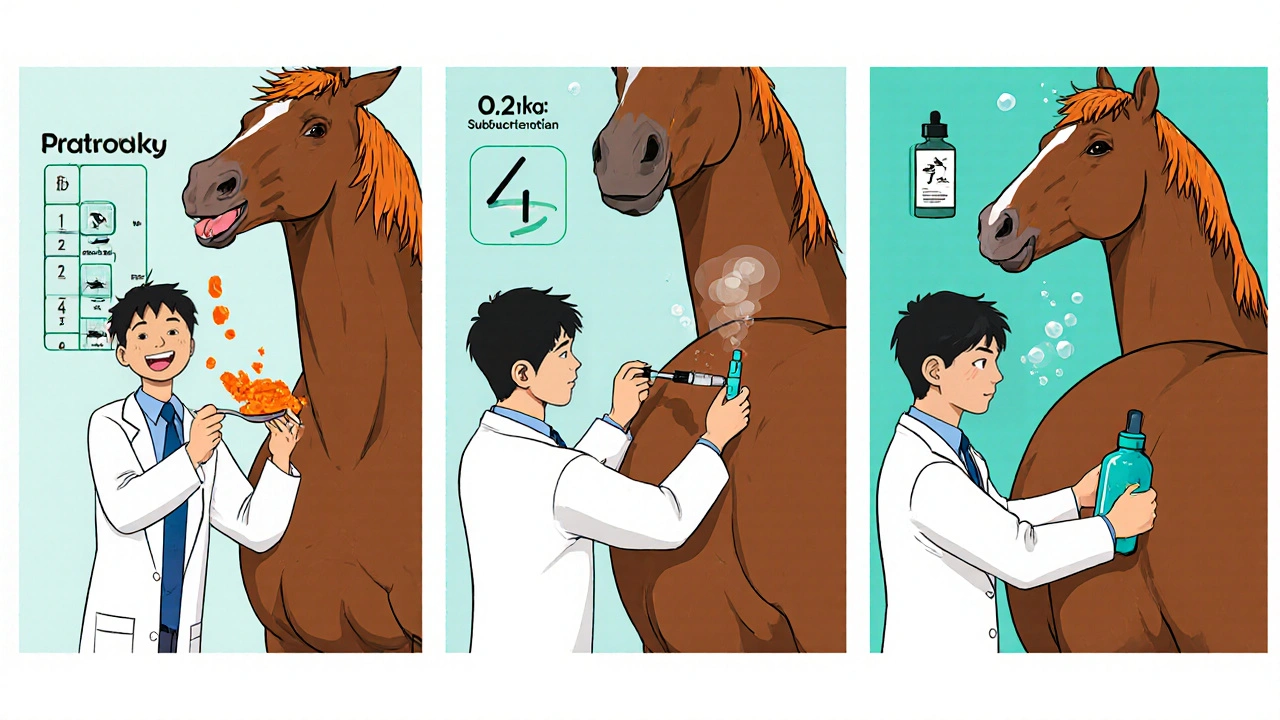When a horse starts coughing, losing weight, or showing a dull coat, parasites are often the hidden culprit. Ivermectin for horses has become a go‑to dewormer, but using it correctly means understanding what the drug does, how much to give, and what risks to watch for.
What Is Ivermectin?
Ivermectin is a broad‑spectrum antiparasitic medication that belongs to the macrocyclic lactone class. It works by binding to glutamate‑gated chloride channels in the nerve and muscle cells of invertebrates, causing paralysis and death of the parasite. First approved for human onchocerciasis in the 1980s, it was later adapted for veterinary use, including the equine market.
Why Use Ivermectin in Horses?
Horses host a range of internal parasites that can impair performance, cause colic, or even be fatal. Ivermectin targets several key species:
- Parascaris equorum - the large roundworm that especially threatens foals.
- Strongylus vulgaris - the bloodworm that can damage the intestinal wall.
- Cyathostomins - small strongyles that cause larval cyathostominosis.
- Fasciola hepatica (liver fluke) - a trematode that attacks the liver.
By eliminating these parasites, ivermectin helps maintain weight, improves coat condition, and reduces the risk of life‑threatening colic episodes.
Approved Uses and Formulations
Regulatory bodies such as New Zealand’s Animal Medicines Board and the U.S. FDA approve ivermectin for oral paste, injectable solution, and pour‑on (topical) formulations. Each form has its own administration technique and absorption profile.
| Form | Typical Dose | Onset of Action | Administration Tips |
|---|---|---|---|
| Paste (oral) | 0.2 mg/kg | 6‑12 hrs | Place directly at the back of the tongue; avoid feeding for 30 min. |
| Injectable (subcutaneous) | 0.2 mg/kg | 4‑8 hrs | Inject into the neck crest; rotate sites to prevent tissue irritation. |
| Pour‑on (topical) | 0.2 mg/kg | 8‑24 hrs | Apply to the mid‑line of the back; ensure skin is clean and dry. |
Dosage Calculation - Step by Step
- Weigh the horse accurately. Use a weigh‑bridge or a body‑condition‑score conversion chart.
- Multiply the weight (kg) by the dose rate (0.2 mg of ivermectin per kilogram).
- Check the concentration of the product you have (e.g., 1 % paste = 10 mg ivermectin per gram).
- Divide the required milligrams by the product concentration to get the amount to administer.
Example: A 500 kg horse needs 0.2 mg × 500 kg = 100 mg of ivermectin. If you have a 1 % paste (10 mg / g), you would give 10 g of paste.

Safety Precautions and Contra‑Indications
Even a drug as safe as ivermectin has limits:
- Age - Foals under 6 weeks are more sensitive; a reduced dose (0.1 mg/kg) is advised.
- Pregnancy - Late‑gestation mares may experience fetal toxicity; most vets defer treatment until after foaling.
- Drug Interactions - Concurrent use of other macrocyclic lactones (e.g., moxidectin) can increase neurotoxicity risk.
- Previous Sensitivity - Horses that have shown adverse reactions (e.g., severe colic) should be re‑evaluated before repeat dosing.
Always store ivermectin in a cool, dry place and keep it out of reach of children and other animals.
Potential Side Effects
Adverse reactions are uncommon but can include:
- Transient lethargy or inappetence (usually resolves within 24 hrs).
- Colic - particularly if a large worm burden dies rapidly in the gut.
- Skin irritation at the injection site (for the injectable form).
If a horse shows severe colic, a veterinarian should be called immediately. Early intervention can prevent a life‑threatening situation.
Resistance Management
Over‑reliance on a single class of dewormer fuels parasite resistance. Here’s a practical plan:
- Perform a fecal egg count (FEC) before each deworming season.
- Apply ivermectin only when the FEC exceeds a threshold (e.g., >200 eggs g⁻¹).
- Rotate classes: follow ivermectin with a benzimidazole or a pyrantel product after 8‑12 weeks.
- Consider targeted deworming: treat only high‑shedding horses rather than the whole herd.
- Keep detailed treatment records to spot trends in reduced efficacy.
These steps help preserve ivermectin’s potency for years to come.
Special Considerations for New Zealand
New Zealand’s equine industry faces unique parasite pressures due to its temperate climate. The Animal Medicines Board recommends annual strategic deworming of all horses with ivermectin in the autumn, followed by a spring FEC‑guided treatment. Additionally, strict biosecurity measures-such as cleaning equipment and preventing cross‑farm grazing-reduce parasite transmission.
Frequently Asked Questions
Can I give a horse ivermectin meant for cattle?
Never. Cattle formulations have different concentrations and inactive ingredients that can be toxic to horses. Always use a product labeled for equine use.
How often should I deworm my horse with ivermectin?
A single annual dose in autumn is typical for most horses. However, high‑risk animals (e.g., foals, performance horses) may need a second dose in spring, guided by fecal egg counts.
Is ivermectin safe for pregnant mares?
It’s best to avoid ivermectin during the last trimester. If treatment is essential, consult a vet for a reduced dose or an alternative dewormer.
What should I do if my horse develops colic after deworming?
Contact a veterinarian immediately. Keep the horse calm, monitor vital signs, and be ready to provide a detailed treatment history.
Can I mix ivermectin paste with feed?
Avoid mixing with feed. Ivermectin is best given directly in the mouth to ensure the correct dose is swallowed and to prevent degradation by feed ingredients.
Quick Checklist Before Giving Ivermectin
- Confirm the horse’s exact weight.
- Calculate the dose using the 0.2 mg/kg rule.
- Check the product label for concentration and form.
- Verify no contraindications (age, pregnancy, recent sensitivity).
- Ensure the administration site is clean (especially for injectables).
- Record the treatment date, dose, and product batch number.
Following these steps helps you get the most out of ivermectin while keeping your equine companions safe and healthy.


Nathan Comstock
October 25, 2025 AT 12:31Ivermectin is the gold standard-don’t let anyone tell you otherwise.
Jennifer Stubbs
October 26, 2025 AT 18:33While the guide is thorough, the blanket recommendation of a single annual dose overlooks regional resistance patterns; a data‑driven FEC approach would cut down on needless drug pressure and protect efficacy longer.
Abhinav B.
October 27, 2025 AT 22:20I agree the guide is good but teh wording on foals under 6 weeks could be clearer – i think many new owners misread the dose and give too much.
Lisa Woodcock
October 29, 2025 AT 02:06It really helped me when I double‑checked my horse’s weight on the farm scale before dosing; the extra few minutes saved me a lot of worry later when the mare showed no signs of colic.
krishna chegireddy
October 30, 2025 AT 05:53Don’t be fooled – big pharma pushes ivermectin as a miracle cure while quietly funding studies that hide long‑term resistance; independent labs have already flagged rising failure rates in some regions.
Shannon Stoneburgh
October 31, 2025 AT 09:40If you skip the fecal egg count and just spray the whole herd, you’re basically gambling with your horses’ health and the drug’s future usefulness.
Terell Moore
November 1, 2025 AT 13:26Ah yes, another "miracle" dewormer that fixes everything – until the parasites evolve and you’re left with a pricey, ineffective bottle to stare at.
Amber Lintner
November 2, 2025 AT 17:13Seriously, this guide is like the blockbuster movie of deworming – full of drama, hype, and a twist ending where you realize you’ve been over‑dosing your horse all along!
Lennox Anoff
November 3, 2025 AT 21:00We have a moral obligation to use ivermectin responsibly; treating every horse indiscriminately shows a lack of respect for both the animal and the science behind parasite management.
Abby W
November 5, 2025 AT 00:46Totally agree! 👍 Always check the weight first and keep a log 📋 – it makes life so much easier when you need to review past treatments.
Grace Silver
November 6, 2025 AT 04:33The dance between parasite and host is a reminder of nature’s relentless balance. When we intervene with chemicals we tip that scale, for better or worse. Ivermectin, a marvel of chemistry, has saved countless equine lives. Yet its power demands humility from those who wield it. A farmer who measures dose with care practices stewardship. Ignoring weight or contraindications is a betrayal of that stewardship. The subtle side effects, like transient lethargy, whisper the cost of convenience. Colic after treatment is not a tale of fate but a signal of miscalculation. Resistance, the silent enemy, grows where we apply blanket deworming without data. Fecal egg counts become the compass pointing where action is truly needed. Rotating classes of anthelmintics is not a gimmick but a strategic safeguard. Record keeping turns anecdote into evidence, guiding future decisions. In New Zealand’s temperate folds the same rules echo, adapted to climate. The moral thread runs deep: we owe the animal both health and respect. A balanced approach honors the science while listening to the individual horse’s story. Ultimately the choice of ivermectin reflects our values as caretakers of living beings.